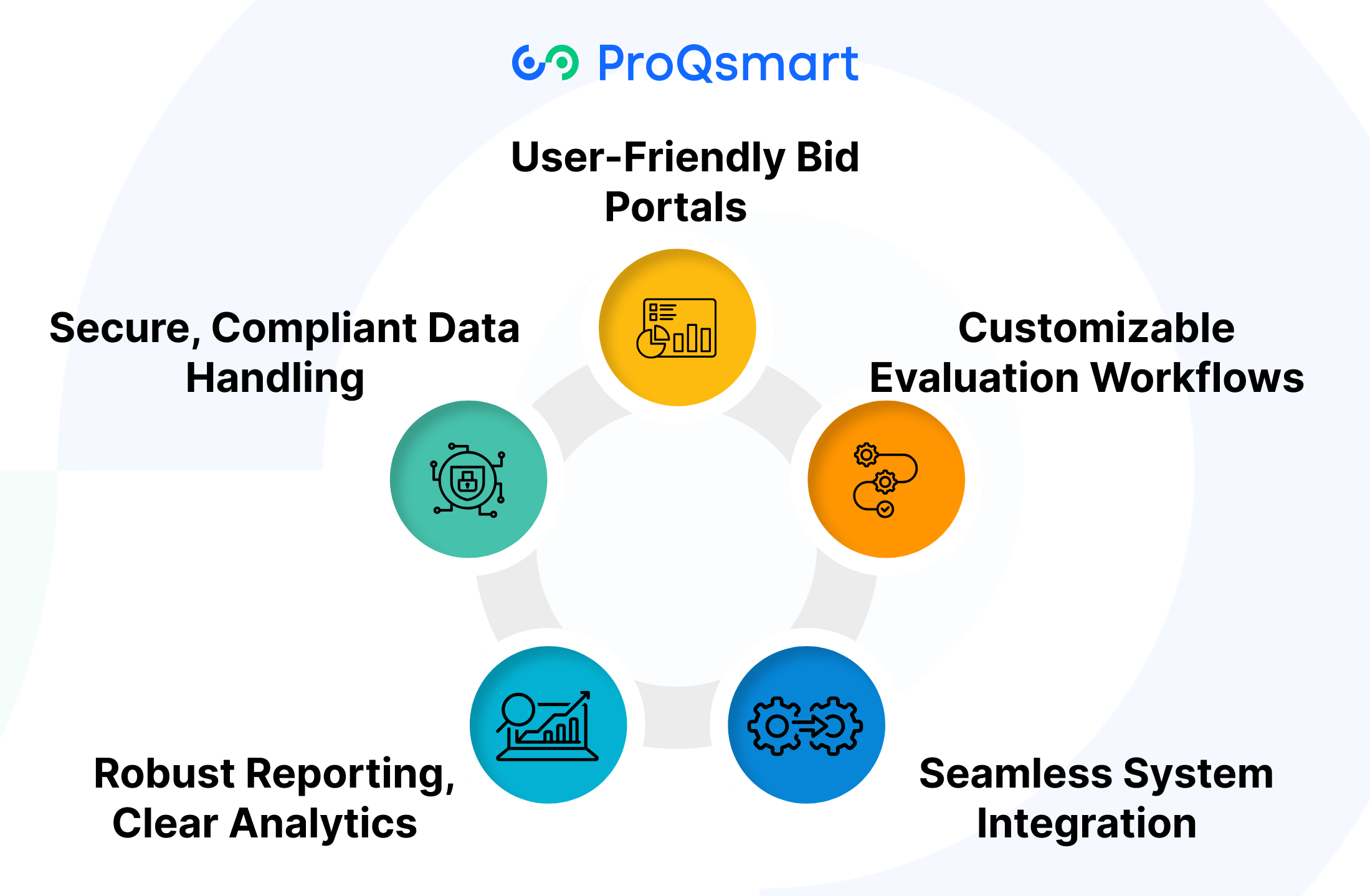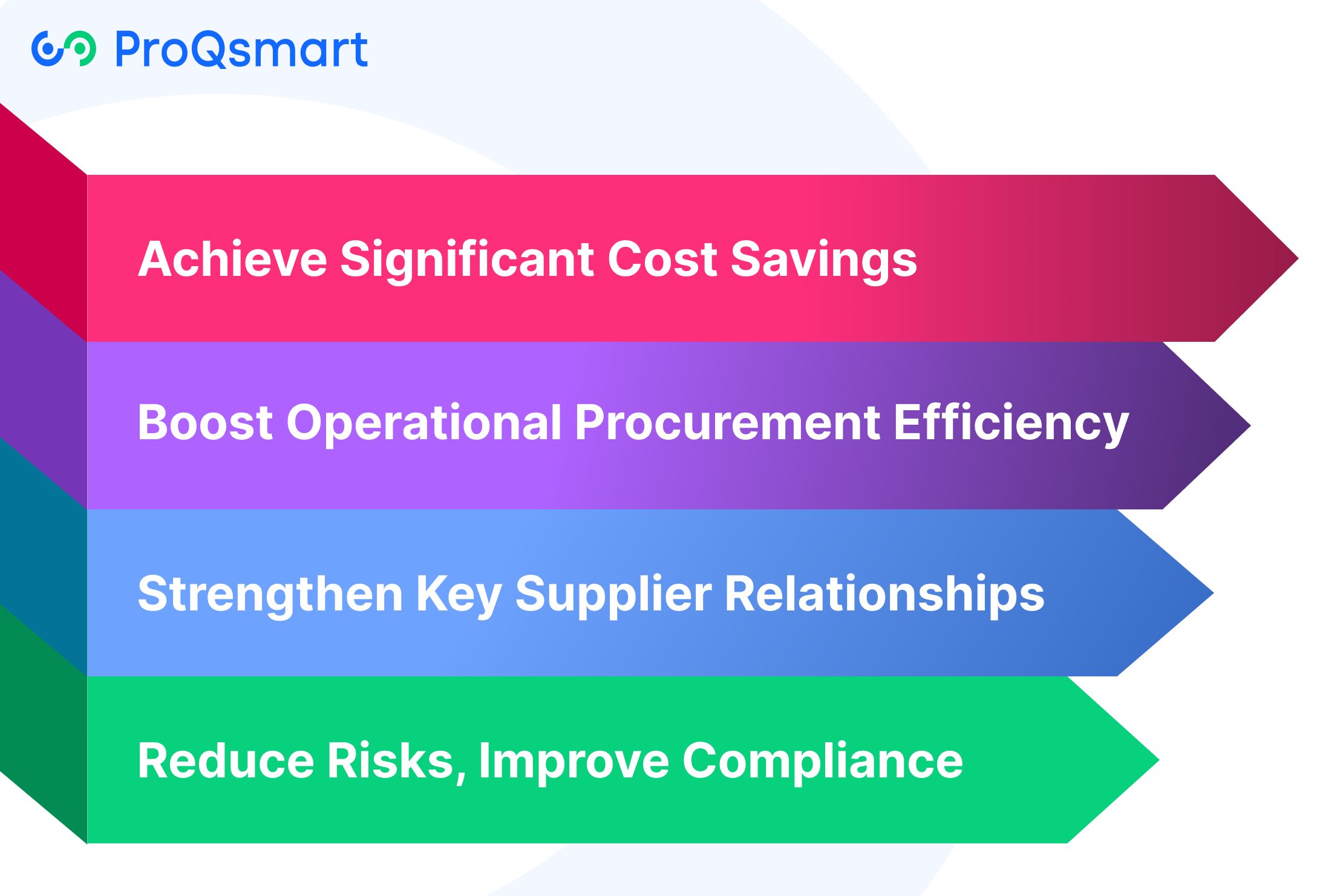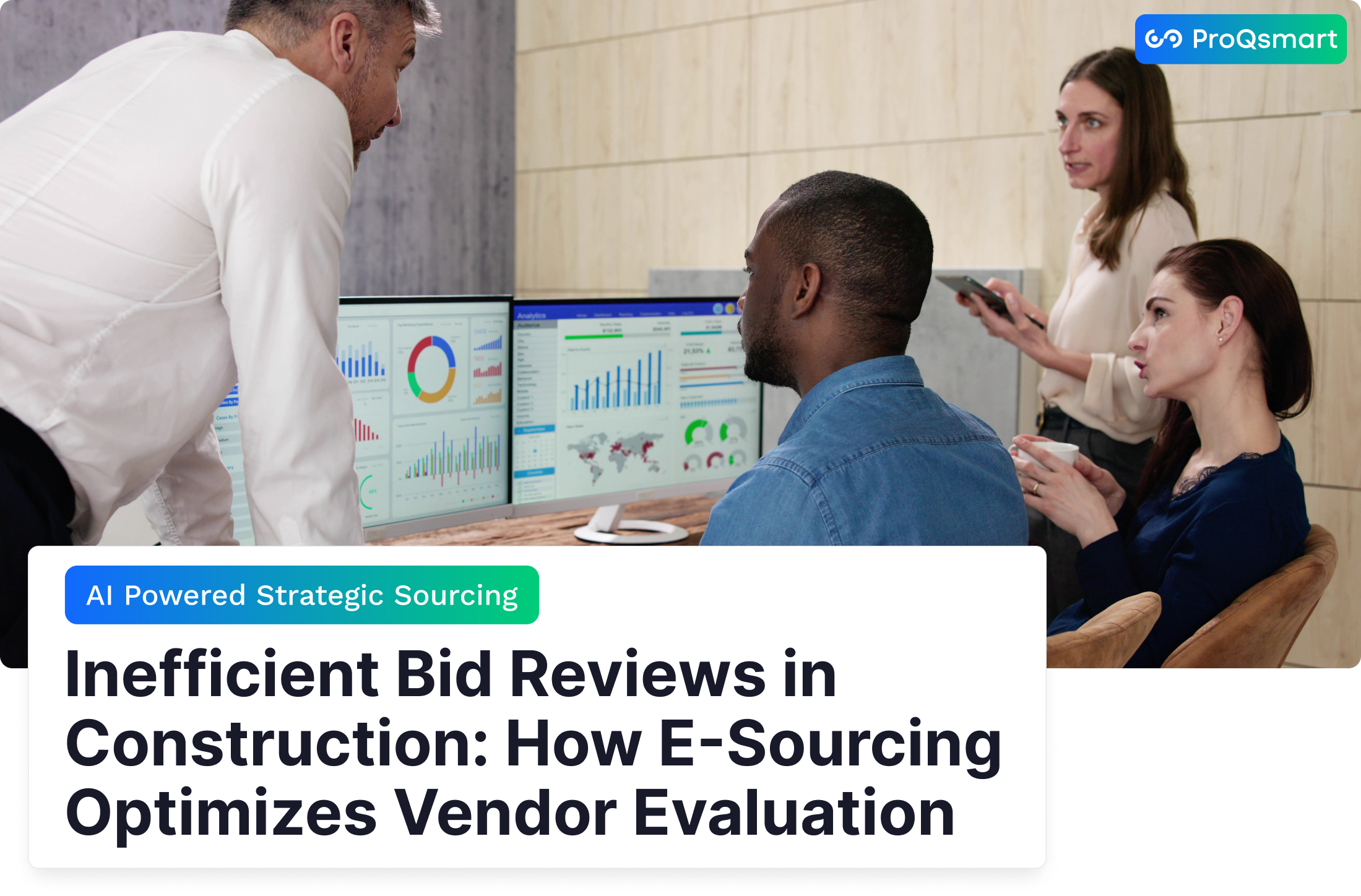E-sourcing has accelerated, clarified, and improved fairness in vendor evaluation for construction projects. With online tools and data. Businesses can create scorecards to get real-time updates, track bids and compare suppliers in a side-by-side view.
Thousands of manufacturers use e-sourcing to identify best-fit vendors faster and reduce errors associated with manual processes. E-sourcing ensures that all teams are applying the same criteria and standards, making it easy to ensure supplier selection is consistent and transparent.
Companies in industries such as automotive, electronics and construction are turning to e-sourcing. They leverage it to build a more resilient supply chain and better manage their costs.
Our central case will be on how these digital platforms work. It will look into the data they use and how they help companies choose the right vendors, every time.
Traditional Bid Review Pains
Traditional bid review processes in specialized manufacturing environments often cause significant challenges that slow down procurement and increase risks. Many firms still rely on outdated methods such as spreadsheets, emails, and paper documents to compare quotes, which hinders effective supplier management. Implementing an e sourcing strategy can streamline the entire sourcing process, reducing inefficiencies and minimizing costly mistakes.
Key Challenges of Traditional Bid Review:
- Inconsistent Comparison Formats: With each bid presented in a different format, making accurate apples-to-apples comparisons becomes nearly impossible, increasing the risk of overlooked errors.
- Human Error and Missed Details: Manual calculations and missed information can lead to expensive change orders or prolonged post-award negotiations.
- Subjective Vendor Scoring: Decisions often rely on personal preferences or historical relationships rather than standardized criteria, resulting in uneven evaluations and overlooked risks.
- Maverick Spending: Lack of uniform processes can encourage purchasers to bypass guidelines, leading to higher costs and inconsistent quality.
- Limited Transparency: Disjointed spreadsheets and fragmented communication prevent stakeholders from gaining a clear, comprehensive view of procurement status and trends.
- Complicated Vendor Onboarding and Contract Management: Important steps may be missed or miscommunicated between departments, causing delays and disputes.
- Increasing Costs Over Time: As manufacturing cycles become faster and more complex, these traditional pains grow more expensive and detrimental to project success.
How E-Sourcing Transforms Vendor Evaluation

E-sourcing has revolutionized the way organizations evaluate and select their vendors. Digital tools streamline competitive procurement, especially through e-sourcing, and procurement teams have begun to prioritize them. This enables them to tackle vendor evaluation with increased efficiency, reduced bias, and increased confidence in their choices.
No more guesswork and complex spreadsheets. With e-sourcing platform doing much of the heavy lifting, teams can focus their efforts on strategy – not just filling in manual evaluation checks. By harnessing automation, intelligent data, and advanced analytics, e-sourcing introduces unprecedented transparency and equity into the procurement process.
1. Automate Tedious Bid Analysis
In the past, bid analysis involved sifting through piles of bids, cross-referencing prices, and scanning terms line by line. However, modern e-sourcing software can automate and streamline most of this labor-intensive process. By leveraging advanced sourcing tools, they automatically analyze and evaluate bids using intelligent criteria, identifying areas of concern effectively.
The smartest platforms can automatically rank those offers based on the criteria you set, ensuring your team knows where to focus their attention first. ProQsmart’s E-tenders module is designed to enhance the tendering process. It simplifies document management, allowing users to upload, match, and compare multiple bids in seconds, thus improving overall procurement processes.
Increased efficiency comes from automated workflows that eliminate manual steps, reducing human error opportunities. This enables teams to transition from evaluation to decision in a matter of hours, not days. Today, more than three-fourths of companies have adopted e-sourcing strategies, saving time and ensuring accuracy in bid analysis.
2. Centralize Critical Vendor Data
Vendor data is useless if you can’t access it. E-sourcing centralizes all supplier information, documentation and previous evaluations in one place. This centralized single source of truth allows teams to work together more efficiently.
Whether they’re all in one building or spread out around the world doesn’t affect this principle! Rather than tracking down documents or having to email back and forth for progress reports, teams can just sign in and find everything they need. Centralized data enables engineering, legal, and finance teams to quickly and easily review a supplier’s compliance records.
It allows them to monitor updates to BOQs. ProQsmart’s platform takes it a step further by automating the pre-qualification process and managing the subcontractors, so that no step or document is missed in the process. As data silos are reduced, collaboration is increased and teams are able to work more expeditiously.
3. Standardize Evaluation Criteria Objectively
Fairness should be your first priority in selecting vendors. E-sourcing allows for pre-determined, objective criteria to be set for evaluation. E-sourcing tools allow teams to create customized scorecards and weighted criteria, ensuring that all vendors are evaluated consistently.
This removes the guesswork and bias from the process. Standardized checklists—whether for price, service, quality or sustainability—ensure that every vendor is judged on the same field. Specialized e-sourcing platforms, such as ProQsmart, come with preconfigured templates and workflows.
These tools require teams to take the same approach for each bid. Over time, this builds trust and consistency in procurement choices, helping teams defend their decisions with hard data if needed.
4. Gain Real-Time Performance Insights
With e-sourcing, teams can receive updates in real-time about suppliers’ performances. By monitoring delivery times, quality scores and compliance rates as contracts progress, platforms provide you ongoing insight into vendor performance.
That’s why having access to real-time data is essential for quickly determining and deciding who’s going to be the best fit. When a supplier doesn’t meet deadlines or required standards, e-sourcing tools can alert you immediately.
With analytics, teams can identify trends, benchmark competing vendors, and adjust course before a minor issue escalates. ProQsmart’s supplier performance monitoring feature, for example, helps teams review if suppliers meet contract terms, so there’s always a clear picture of who’s delivering and who’s not.
5. Streamline Vendor Qualification, Risk Checks
Vendor qualification and risk checks were a bottleneck to procurement. Today, e-sourcing tools automate most of this process. They house supplier documentation, alert users to missing documentation, and ensure compliance through customizable rule sets.
Teams can conduct RFI and RFQ processes entirely online, allowing potential vendors to opt in and out with ease. They can have everything in one location! Risk checks—including reviewing insurance, checking financials, or tracking past performance—are completed quicker and with less manual effort.
With ProQsmart, pre-qualification and compliance are automated and easy. This provides teams with the assurance that a supplier is capable of fulfilling required standards before any agreement is finalized.
6. Balance Hard Data, Soft Vendor Insights
After all, data speaks volumes, but it doesn’t speak about everything. E-sourcing makes it easy to see prices, scores, and timelines, but it helps teams keep track of softer details—like communication quality or how well a supplier solves problems.
Shared notes and feedback features allow teams to document their interactions and impressions of working with each vendor, providing rich context to the quantitative data. This combination of hard data and soft insights makes for better, more human decisions.
Teams can see and compare all bids side by side. They can see who’s a pleasure to do business with and who makes the extra effort when the chips are down.
7. Leverage Analytics for Trend Spotting
E-sourcing platforms are equipped with analytics tools that identify trends that no spreadsheet would be able to find. Teams can identify which vendors are improving—or deteriorating—over time, monitor trends in cost, or detect changes in competitive market behavior.
This not only provides immediate insights, but allows agencies to plan future sourcing accordingly. Analytics could reveal that one vendor is always the fastest to meet a deadline. This active engagement allows them to be more responsive and agile, especially for time-critical tasks!
If a market is beginning to change direction, teams can identify that at the outset. They can use this information to proactively optimize their supplier mix and maintain an edge. ProQsmart provides users with all these insights through easy-to-understand dashboards and reports, allowing your teams to respond quickly and intelligently.
Key E-Sourcing Features for Construction

E-sourcing offers concrete, real-time advantages to construction procurement teams.
Onboarding tools are essential for this sector, as they need to match the quick tempo, unique requirements, and rigorous compliance guidelines of large-scale projects. Effective e-sourcing solutions centralize sourcing steps—such as RFI, RFQ, bid analysis, and contract award—so users see the full picture at every stage.
Dashboards provide teams with a 360-degree view of supplier data, bid status, and contract progress. Automated workflows eliminate repetitive tasks, leaving more time for higher-level, value-adding activities.
User-Friendly Bid Portals
User-friendly, intuitive bid portals allow your team to work quickly while keeping the vendor base responsive and interested. When bid portals are user-friendly, vendors are more willing to register and submit bids, adding valuable competition.
Simplified navigation and logical form layouts lead to a better user experience, with no room for miscommunication or mistakes when placing bids. The most user-friendly portals include open designs that are usable by anyone.
They allow internal buyers and external suppliers alike to procure what they need in short time frames without extensive training.
Customizable Evaluation Workflows
We know that construction projects are seldom cookie-cutter templates. Customizable evaluation workflows are crucial for adapting to the unique needs of each project.
Flexible workflows allow teams to tailor evaluation processes to the size, type, or risk level of their projects. Customizable scoring checklists and tools produce more effective vendor reviews.
If priorities shift, users can adjust stages in real time, accommodating large capital investments as well as quick-turnaround maintenance and rehabilitation projects. This is where solutions like ProQsmart truly excel, offering customizable workflows to adapt to individual project requirements and automate standard quality control checks.
Seamless System Integration
Construction abuts or touches so many different systems—finance, scheduling, compliance. E-sourcing tools that integrate with these platforms help maintain the flow of data while reducing repetitive manual tasks.
Through complete collaboration, construction project managers can easily circulate supplier information, project budgets, and project timelines between teams. That helps make more informed decisions, more quickly.
Robust Reporting, Clear Analytics
Robust reporting and clear analytics are extremely important for effective procurement. Teams should have accessible, straightforward views into supplier-scoring, bid-trend analysis, and contract-status tracking.
Good analytics help identify which vendors are consistently meeting targets and where the most significant cost savings are achieved. These reports help prioritize data-driven needs and ensure all stakeholders are aligned.
Secure, Compliant Data Handling
Data protection is no longer a nice-to-have; it is essential for compliance with secure data handling. Procurement platforms need to comply with stringent security requirements when it comes to contracts and financials.
Audit trails and role-based access controls protect sensitive information and support compliance with industry regulations and standards. ProQsmart ensures accurate, auditable data, giving teams peace of mind.
Strategic E-Sourcing Implementation Steps
Strategic e-sourcing provides manufacturing and procurement teams with greater control and insight throughout the vendor evaluation process. The process begins by categorizing purchases into obvious categories—such as production inputs, indirect materials, or capital assets. This provides the foundation for a targeted sourcing strategy.
It enables teams to implement a field-tested, seven-step strategic sourcing process! Teams make the most progress when they go incrementally. They begin by defining measurable objectives, then choose the best solution, and then adapt based on performance.
Define Your Clear Objectives First
To be truly effective, teams must have clear, measurable, and shared goals established before e-sourcing is deployed. Realistic, measurable, and time-bound objectives help hold all parties accountable and ensure the sourcing strategy aligns with broader organizational goals.
For instance, they may want to reduce overall costs by 10% or increase the reliability of their suppliers. Measurable targets—such as turnaround time for bids or supplier defect rates—ensure that you can monitor and determine if the process is functioning.
When teams from engineering, procurement, and finance work together to define these targets, they develop more achievable objectives. This collaborative engagement helps to create better buy-in from each of the players.
Choose Your E-Sourcing Platform Wisely
Choose your e-sourcing platform wisely. During the selection process, teams should search for software that meets their specific needs, like document and information management, real-time collaboration and communication, and supplier performance tracking capabilities.
ProQsmart, for instance, leverages AI to make the bidding process easier, streamline supplier relationship management, automate various workflows, and monitor budgets. Teams should read user reviews and ask for demos.
They have to consider vendor support and training options to ensure the platform is sustainable long-term.
Integrate With Existing Procurement Tech
An optimal e-sourcing implementation integrates easily with existing procurement technology, including tech stacks that rely on legacy tools. This simplifies data movement, reduces manual effort, and prevents duplication of records.
Collaborating with IT early on prevents major issues from arising and protects vital data from being compromised. An integrated system provides every stakeholder a single source of truth for all e-sourcing activities.
Continuously Monitor and Optimize Use
Following rollout, teams should be continuously monitoring performance and optimizing how they’re using the tool. User feedback, usage analytics, and continuous review processes are critical to identifying content gaps.
In the long run, this continuous re-calibration makes for better supplier negotiations and increased compliance. It can help save money too—up to a 12% annually in fact!
Broader Wins: E-Sourcing’s Ripple Effect

E-sourcing just speeds up the process of evaluating vendors. Rather, it carries with it a direct and indirect ripple effect across the procurement landscape. By leveraging digital tools, organizations create more resilient supply chains and maintain higher service levels—all in the face of inevitable disruptions.
With real-time monitoring and increased visibility, fleet teams can identify mistakes before they become big problems and take corrective action quickly. Long-term, the benefits go far beyond saving money and time. More importantly, they create the kind of foundation that allows for sustainable economic growth.
Achieve Significant Cost Savings
With e-sourcing, organizations experience actual reductions of procurement costs. By automating time-consuming, paper-intensive processes such as bidding and contract management, e-sourcing reduces administrative burden and human error.
Case in point, ProQsmart allows project teams to easily create and manage e-tenders, monitor budgets, and achieve savings through AI-powered insights. This allows for every dollar spent to be tracked, which provides leaders with an opportunity to identify savings and prevent waste.
Over time, these wins compound, creating significant savings on the bottom line. Time to demonstrate impact teams need to begin measuring year-over-year savings to demonstrate the effect.
Boost Operational Procurement Efficiency
E-sourcing tools help streamline vendor verification and selection. Automation handles routine processes, allowing procurement professionals to focus their time on more strategic activities.
With powerful tools such as automated workflows and real-time collaboration, teams can work faster from sourcing to contract. This helps achieve shorter lead times with fewer missing or inaccurate supplier records.
Measuring time-to-source and contract cycle speed helps to identify where the most impactful efficiency gains are.
Strengthen Key Supplier Relationships
Digital sourcing platforms facilitate supplier communication and information sharing. ProQsmart’s collaboration tools ensure every team member stays aligned—every step of the way, from quotes to performance reviews.
When records are clear and open, it builds public trust while making it easier for everyone to work together to identify problems. Stronger relationships ensure that suppliers will rise to the occasion in difficult circumstances.
This support is essential to ripple effect from disruptions.
Reduce Risks, Improve Compliance
E-sourcing reduces risk by standardizing and documenting each step. All deals comply. Compliance tools ensure that every deal is above board and maintain audit trails that prove it.
Reduced risks, improved compliance. E-sourcing tools, such as supplier performance tracking and automated pre-qualification, help guarantee that only reliable partners enter the supply chain.
This concentrated oversight is beneficial to prevent errors that would result in significant loss of service or additional expenditure.
Conclusion
E-sourcing offers construction teams powerful advantages by eliminating the complexities of traditional bid reviews. With just a few clicks, teams can efficiently compare bids, track evaluation scores, and review comprehensive vendor histories—eliminating guesswork and paper-based processes. Automated tools streamline the identification of qualified vendors, ensuring fairness and transparency throughout the evaluation process. This clarity reduces errors and minimizes liability at every stage.
For forward-thinking, agile construction firms, e-sourcing delivers measurable benefits such as faster vendor selection, simplified compliance, and more competitive pricing. Leveraging e-sourcing is essential to optimizing vendor evaluations and maintaining a strategic edge in a competitive construction environment.
To learn how ProQsmart can enhance your vendor evaluation process, schedule a demo and take the first step toward smarter procurement.




